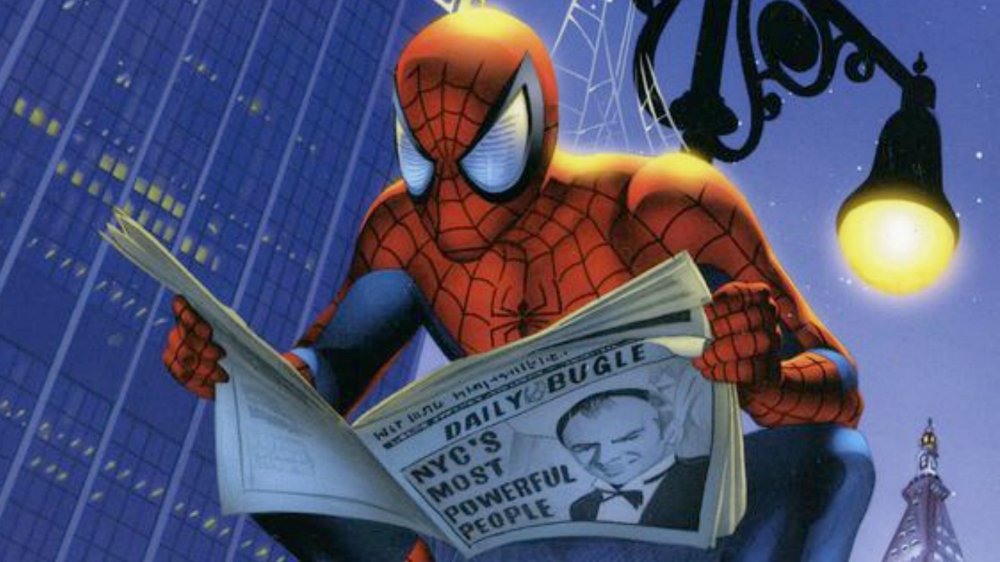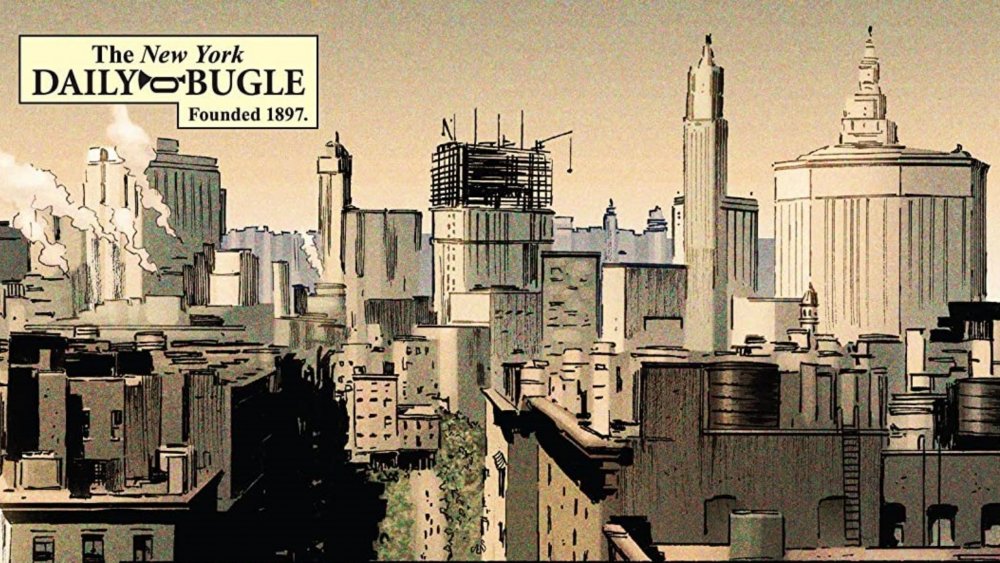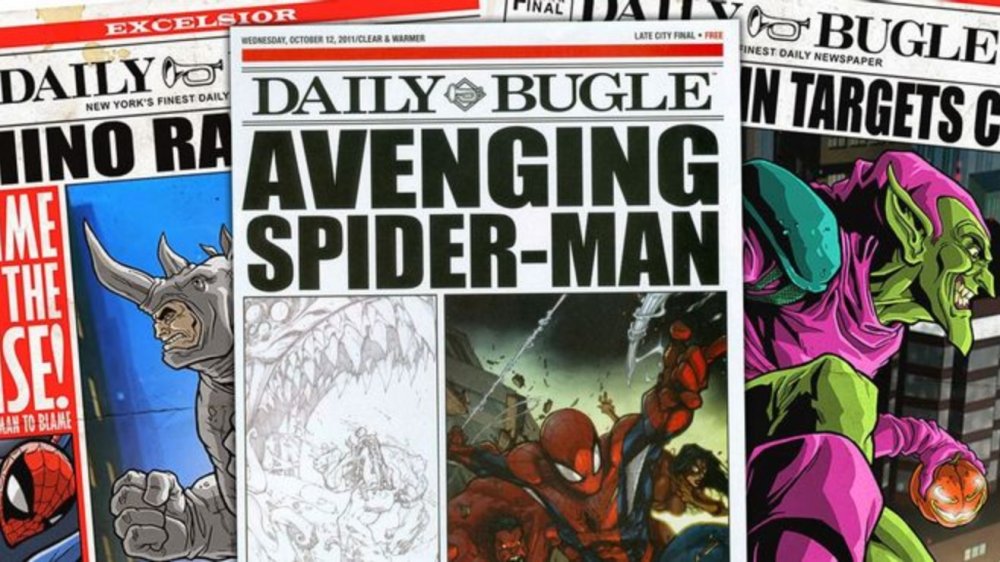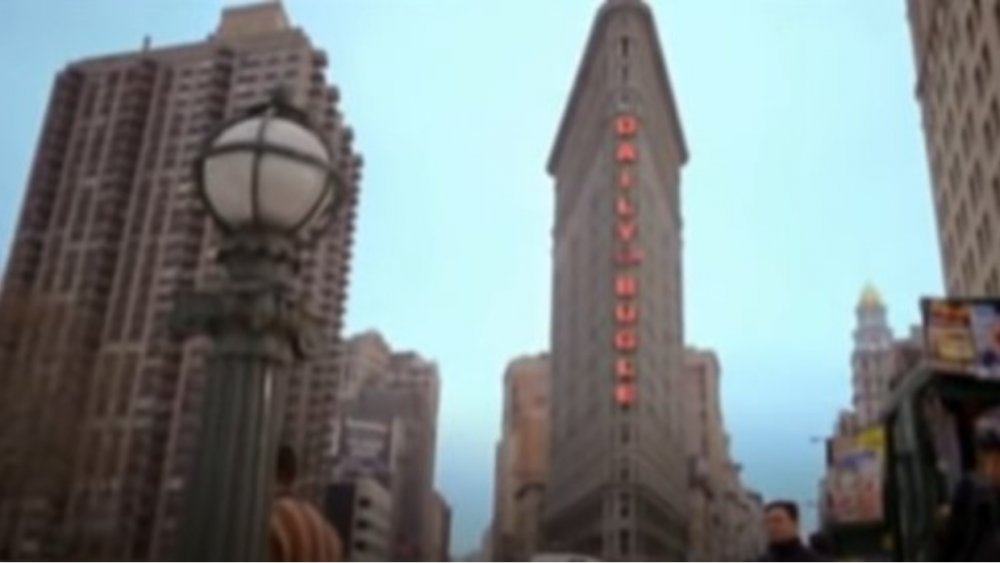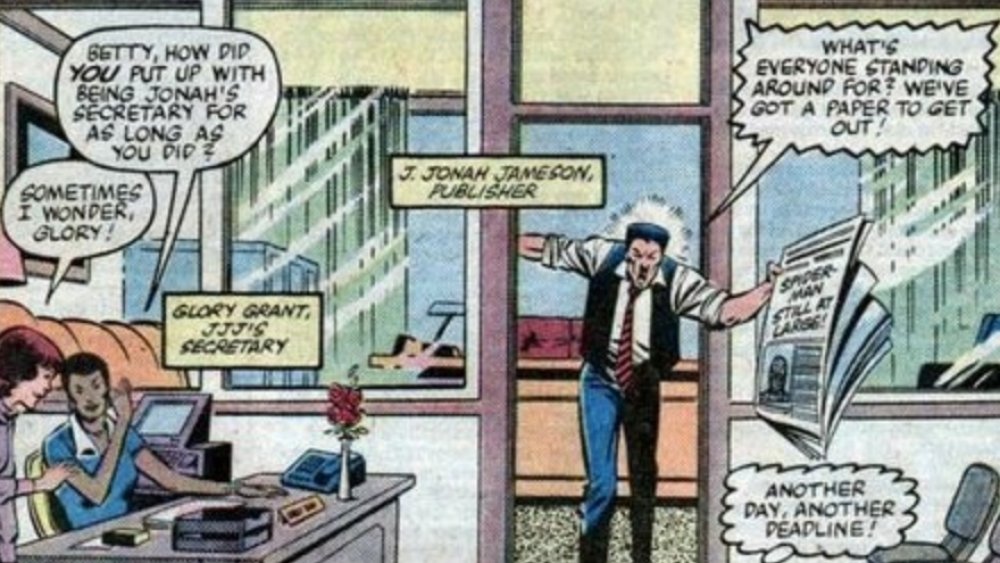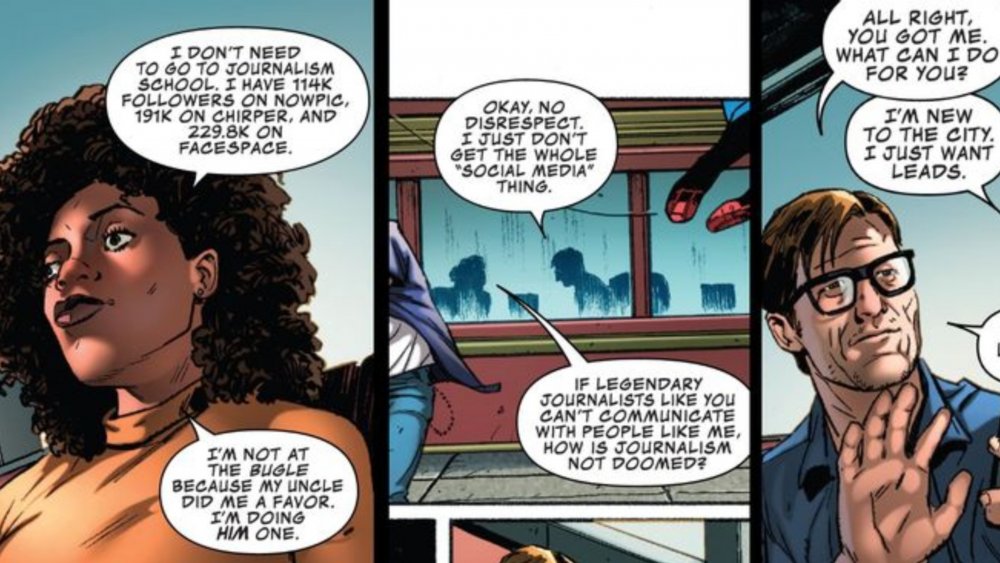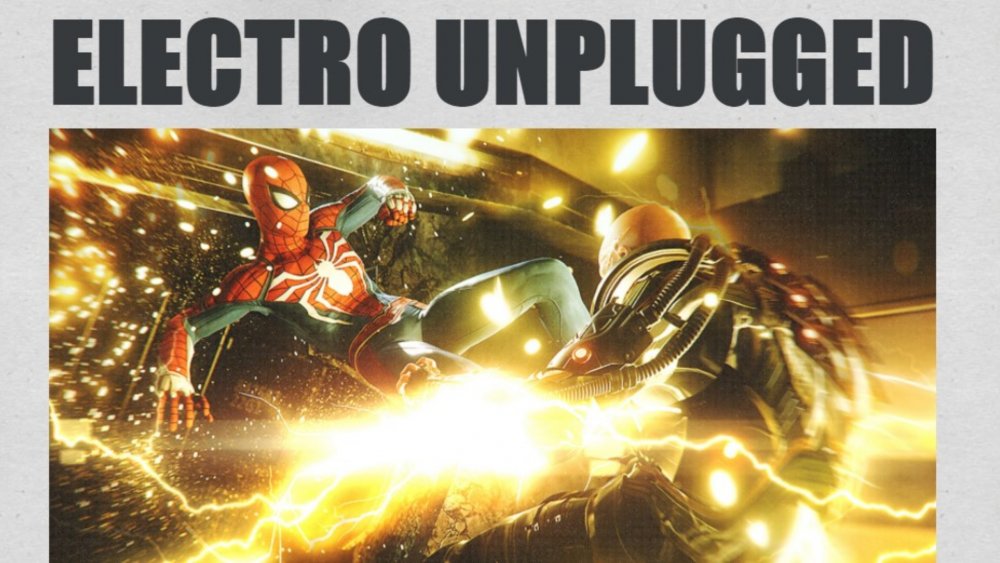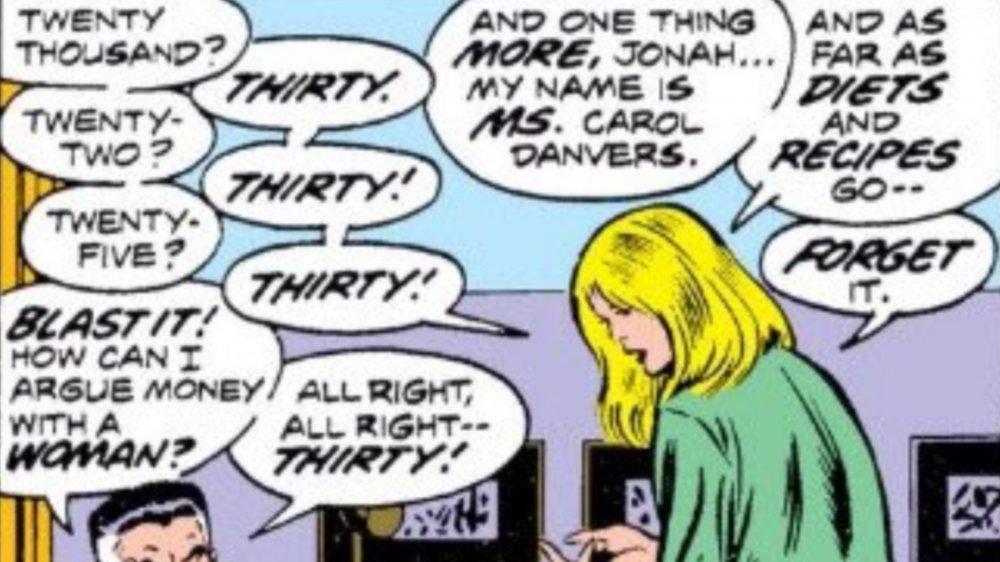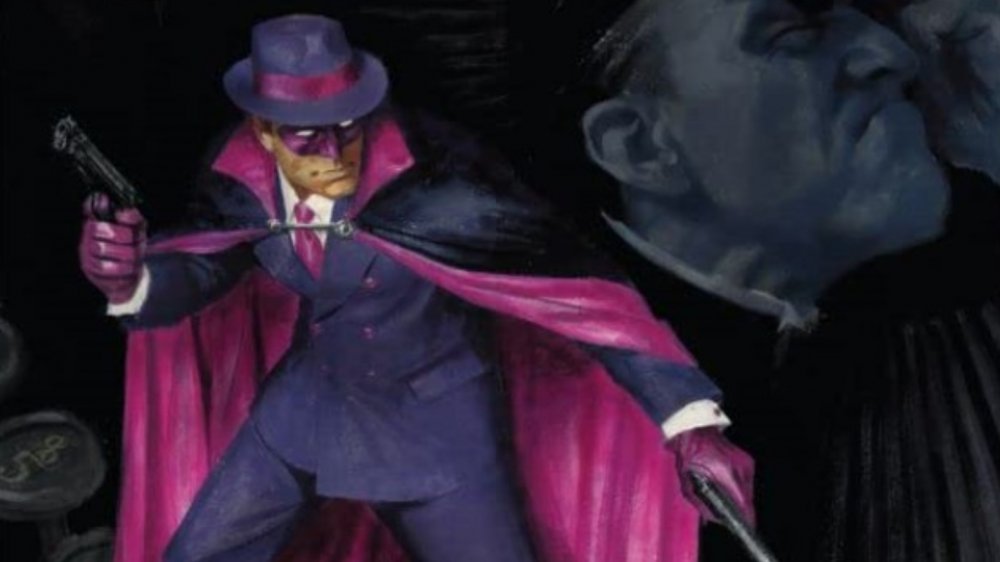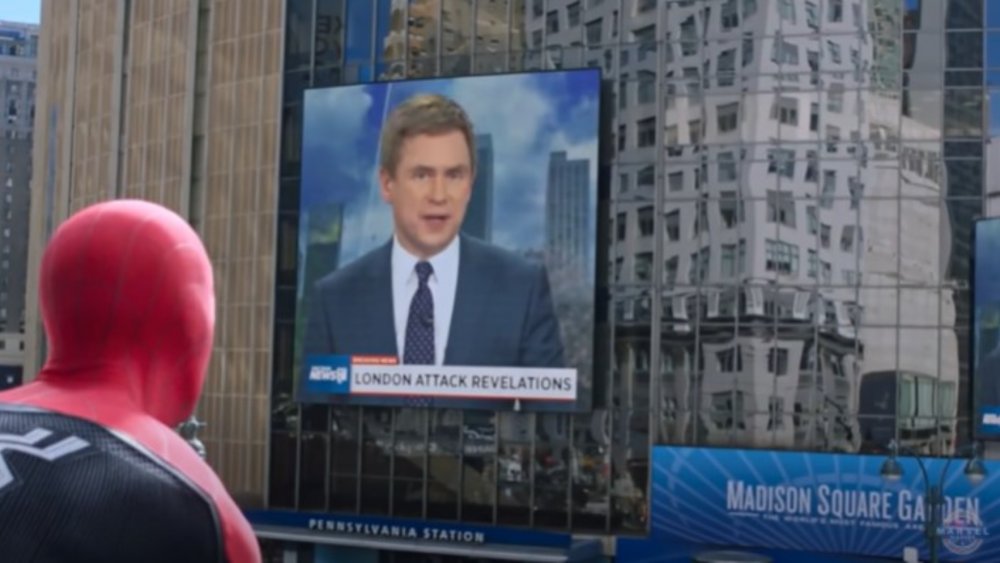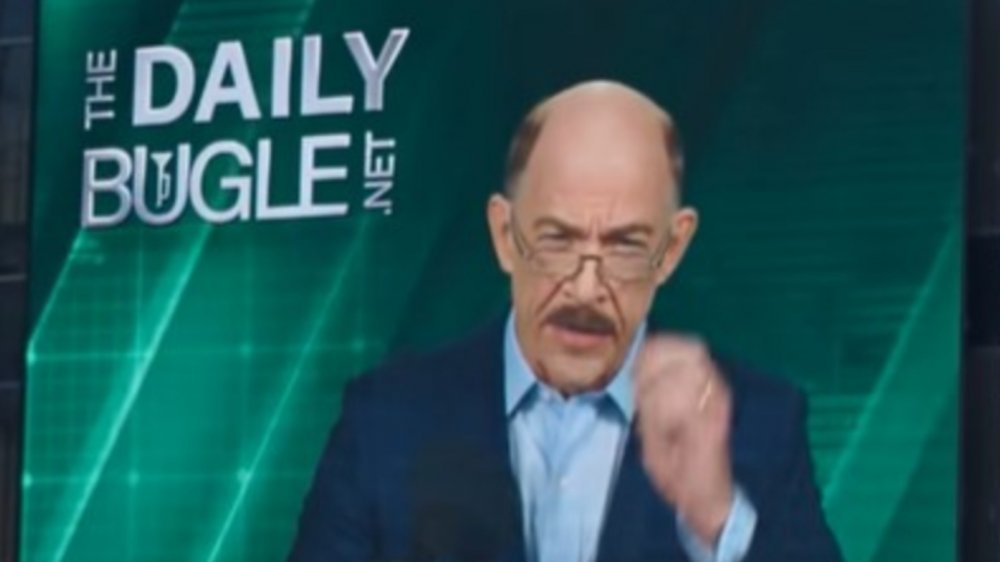The Untold Truth Of Spider-Man's Daily Bugle
In Metropolis, The Daily Planet handles all the news that's fit to print, but in the Marvel universe, The Daily Bugle breaks news — and sometimes wild rumors — to heroes, villains, and regular New Yorkers. The Bugle bills itself as "New York's finest daily newspaper," a questionable title when the tabloid slings mud Spidey's way. But to its credit, Marvel's favorite news outlet also has several dogged reporters who ferret out corruption and help people in their community, even as they cover fantastical events and superpowers.
The Bugle provides verisimilitude within the Marvel Comics world, but it has also become an icon. Visitors to the Islands of Adventure theme park at Universal Studios Orlando can walk through the Bugle newsroom, see Spider-Man's prints on the darkroom ceiling, and count the cameos by late Marvel Comics writer, editor, and publisher Stan Lee. One sharp-eyed Redditor at Disneyland after Avengers: Infinity War in 2018 spotted a Daily Bugle with front-page headlines such as, "'O' No They Didn't! Iron Man, Spider-Man Seen Fighting Alien Foes" and "Vibranium, Miracle Metal? What the Future May Bring."
A 2020 limited comic series, Amazing Spider-Man: The Daily Bugle, once again celebrates the power of this fictional press. As the Bugle reinvents itself in a digital age, the series spotlights and celebrates the all-too-human but scrappy reporters who "scour the underworld and lean on contacts for vital information," using their journalistic principles and techniques instead of superhuman abilities, as ScreenRant notes. Here's some of the Bugle's marvelous story.
Tabloid inspiration
As a newspaper in the Marvel Universe, the Daily Bugle was founded in 1897 (some comics say 1898). But in real life, it first appeared in 1943's All-Winners Comics No. 11, thanks to Stan Lee and Marvel artist, writer, and editor Jack Kirby. That issue featured Captain America, the Human Torch, and some strange attacks involving poisonous gas. The Bugle later turned up in 1962 in Fantastic Four No. 2, one of several city papers covering a manhunt for the heroes.
The Bugle is a pastiche of two long-running New York City tabloids, the New York Daily News and the New York Post. While both papers have plenty of attitude, the Post is known for its gonzo headlines, such as 1983's "Headless Body in Topless Bar," a line that's become a pop-culture legend. Depending on who's at the helm, the Bugle of page and screen either leans more toward the Post, as in 2002's Spider-Man (with the commemorative Moon Landing front page proclaiming, "Take a Walk!") or the slightly more staid Daily News. (J. Jonah Jameson is a Post master. Joseph "Robbie" Robertson is a News man all day long.) Its chief rival is the arguably less famous Daily Globe, or Marvel's version of The New York Times.
Promoting Marvel events in the real world
The Bugle had its first limited series – three issues published in black and white — in 1996. But it hasn't always been just a newspaper for Marvel characters to read. Since 2006, Marvel has churned out real issues of the Bugle full of interviews, details on upcoming titles, and teases of crossover story arcs such as Civil War, Civil War II, and 2011's "Spider-Island," where the Jackal's genetic experiments transmit Spidey-like abilities throughout Manhattan. Editor and publisher J. Jonah Jameson sometimes contributes editorials, and one reporter in the Daily Bugle Civil War Newspaper Special is named Lee "Your Man at the Bugle" Kirby, an homage to Stan Lee and Jack Kirby.
For PlayStation's popular Marvel's Spider-Man video game, the Bugle ventures online with four issues full of articles written by Bugle staples such as Ben Urich, Kat Farrell, and Betty Brant. Even Mary Jane Watson gets a byline, writing an op-ed about how New York's rising rent prices squeeze out millennials.
Trumpeting news onscreen
In the comics, the Bugle's headquarters have been at 39th Street and Second Avenue since 1936, although with changes of ownership — and its offices being demolished at least once — the paper also hops around Manhattan to find suitable real estate. Onscreen, its offices are in the landmark Flatiron Building at 23rd Street and Broadway, a dramatic triangle of limestone and terra-cotta designed in the Beaux-Arts style.
Director Sam Raimi's 2002 film Spider-Man first located the Bugle inside the Flatiron, albeit with a marquee that looked way out of place to anyone familiar with the frequently photographed facade. The animated series The Spectacular Spider-Man of 2008 and 2009 kept the Bugle at the Flatiron, just without the red letters. While the Flatiron hasn't hosted a newspaper in real life, it was the home for Macmillan Publishers for more than a decade, as well as sheet-music publishers, dentists, and milliners.
The onscreen Daily Planet has a slight leg up here. It co-opted the use of another landmark, the Art Deco Daily News Building at 220 E. 42nd St., for its headquarters in the 1970s Superman franchise — the real headquarters of the Daily News at the time.
Wildly different leadership
J. Jonah Jameson is arguably the Bugle's most famous boss, bursting out of his office and barking orders on what seems like a dozen things at once. "Jolly Jonah" began his journalistic career at the Bugle as a newspaper delivery boy and then a copy boy. As a reporter, he was a wartime correspondent who criticized "glory-seeking vigilantes" and costumed heroes alike. Jameson actually can have a good heart, publicly supporting civil rights and being a bulldog on organized crime as editor-in-chief — something easy to miss when he's concocting sensationalized headlines around Peter Parker's Spider-Man photos. Jameson later purchased the Bugle with his inheritance during a period of financial trouble and has even lived in a penthouse above the offices.
Other owners and publishers over the years include the Green Goblin himself, Norman Osborne (!), and Joseph "Robbie" Robertson, the former city editor, Peter's mentor, and the levelheaded balance to Jameson's brashness. In the new Amazing Spider-Man: The Daily Bugle limited series, Robbie tells Peter and his loyal clutch of reporters they're going back to the tactics that put the Bugle on the map: solid investigative reporting.
"No more scrambling to just cover the daily noise," Robertson says. "This paper is over a century old. Post-digital. We're smaller and poorer. But we're also more agile too. ... You get two families in life. The one you're born to and the one you choose. The Daily Bugle is the one I chose."
Newsroom faces old and new
The Bugle's reporters never seem to age, although they can change jobs and beats depending on the storyline. Betty Brant started out as Jameson's secretary but now works on sensitive investigative stories. Gloria "Glory" Grant also began as a secretary but later became a photographer and journalist. In the 2020 limited series, she's the senior national desk editor with a focus on local politics — and with the Kingpin, Wilson Fisk, as mayor, she'll need her own "Spidey sense."
Katherine "Kat" Farrell started as a Bugle intern but proved her investigative chops enough to anchor 2002's urban noir limited series Deadline, checking out crimes involving superheroes (what Kat calls "Capes"). Robertson in the 2020 Bugle series assigns her to check out rumors involving the voting machines in the mayoral election. (He also bumps Peter from science editor back to a photographer, giving our favorite webhead more time to swing around town.)
Ben Urich's tenacious shoe-leather reporting crosses over into a couple of Marvel titles, notably Daredevil. (Vondie Curtis-Hall portrayed him in Netflix's 2015-2018 Daredevil series.) The 2020 limited series has some fun pairing the old-school Ben with Robbie's tech-savvy niece, Chloe Robertson. At one point, Ben offers to pull some street cam footage from a guy he knows in traffic enforcement to chase a lead. Then Chloe shares the shots she's gathered from the selfies of social media influencers. "Influencers? What's that, like, some kind of psychic thing?" Ben asks.
Blowin' down The DB
The Bugle hasn't always managed to stay in one piece, which is no surprise in a city full of superpowered beings. In one Amazing Spider-Man storyline in the late 1990s, Jameson suffered a heart attack, and his wife sold the Bugle to rival publisher Dexter Bennett. Bennett renamed the paper as The DB and turned it into a scandal sheet. As its reputation plummeted, several reporters jumped ship to Front Line, a responsible but struggling alternative newspaper that journalists Ben Urich and Sally Floyd founded during a 2006 Civil War tie-in.
Meanwhile, Jameson became mayor, and he and Spidey set their differences aside to foil Electro. When the supercharged villain targeted Bennett, Spidey intervened, but the battle demolished The DB's offices. Not wanting to see the Bugle die, Jameson cashed in his shares from the original buyout, gave the money to Robertson, and asked him to revive Front Line as the new Daily Bugle.
Ms. Marvel, Bugle editor supreme
Before she became Captain Marvel, Ms. Marvel herself edited the Daily Bugle's version of Ms. magazine. In 1977's first issue of Ms. Marvel, Carol Danvers, fresh out of the US Air Force, visits the Bugle's offices looking for work. She winds up with more responsibility than she anticipated when Jameson takes one look at her and hires her on the spot to edit Woman, a magazine that the Bugle published. Jameson had just fired the previous editor for printing stories about careers for women and interviews with real-life feminists such as writer and activist Kate Millett.
Jameson had his own editorial plan, which included more recipes and less of this Women's Lib stuff. Carol's first response was to ask for better pay. She then put herself in costume as Ms. Marvel landing a punch on the cover of the next issue. Naturally, Jameson fired her, too, although Carol found a replacement, seasoned journalist Tracy Burke.
Carol's time at the Bugle "wasn't always good, and it wasn't always particularly feminist," but fans like those at SyFy Wire still found it entertaining to see Jameson encounter the immovable force that Carol can be. As Marvel itself asks, "Have you ever met Carol Danvers?"
Yeah, but can they type?
The Daily Bugle has had other questionable hiring choices. Back in the Amazing Spider-Man run of the 1960s, Jameson hired, fired, and rehired a villain: Frederick Foswell, a crime bigwig with the rather obvious name of Big Man. Foswell lived a double life, controlling New York's corrupt criminal community between filing stories on deadline. Once he was arrested, he agreed to be a police informant, and Jameson rehired him — but his path on the straight and narrow didn't last long.
The Phantom Reporter has a far better moniker for a Daily Bugle columnist. The dapper phantom in purple first appeared during the 1940s in Daring Mystery Comics, published by Marvel predecessor Timely Comics. In 2008, Marvel brought the Phantom Reporter's alter ego, Richard Jones, and other 1940s heroes into modern times in The Twelve, having them wake from suspended animation to navigate the 21st century. The Bugle's syndicated columnist editor, Sam Kingston, decided to capitalize on Jones' background as a reporter during World War II and hired him to write about life in that era for readers in the new millennium.
Jones was glad to oblige, donning a cape, fedora, and mask while checking out crime scenes between stories. "So why the mask if everybody knows your name?" one character asks him. "It's a lifestyle thing. Keeps my adoring public happy," the Phantom Reporter replies, adding, "Give it time. This is my first job since April 1945."
Real news anchor, Bugle headlines
Thanks to delivering news bulletins in the Marvel Cinematic Universe and other films and TV shows, real-life New York news anchor Pat Kiernan is a familiar face beyond the Big Apple. He's appeared as a newscaster since 2001 in Spin City, Night at the Museum, 30 Rock, and 21 Bridges, plus 2012's The Avengers, Iron Man 3, Doctor Strange, and Netflix's Daredevil and The Punisher.
With Kiernan in 2019's Spider-Man: Far From Home, the Marvel Live crew asked him to recreate his regular morning segment on NY1 called "In the Papers." But instead of offering a quick overview of the day's real headlines, Kiernan read some Daily Bugle headlines, such as "Goliath Returns to the Avengers," "Dr. Octopus Captured," and "Publisher Calls Galactus Hoax."
Asked what he would do if Galactus really came to Earth, the news veteran gamely said, "Get a live truck as close to the giant purple being as possible."
The Bugle of the future
As Spider-Man's world evolves, so does the Daily Bugle. It shows up in several Spidey-related video games, for instance. PlayStation's Marvel's Spider-Man series gets kudos for the distinguished look of the Bugle's office building, plus integrating the newspaper into the storyline with Mary Jane Watson working there. One of the Bugle's cuter video game appearances has to be in Lego Marvel Super Heroes. Deadpool introduces a bonus level (complete with bugle fanfare) about how S.H.I.E.L.D. Agent Phil Coulson brings Doc Ock to the Bugle to clean up the mess he's made. Play as J. Jonah Jameson, and you can throw newspapers.
Speaking of J.J.J., he took the Bugle online in the latest Spider-Man film. Oscar-winner J.K. Simmons (Whiplash), who memorably played Jameson in director Sam Raimi's Spider-Man trilogy of the early to mid-2000s, returned in character during a mid-credits scene in Spider-Man: Far From Home that drove longtime Spidey fans wild. Just after the web-slinger (Tom Holland) takes MJ (Zendaya) for a harrowing spin around Manhattan, the couple sees a news report on a jumbo TV screen outside Madison Square Garden.
The footage shows Spidey's climactic fight with Mysterio (Jake Gyllenhaal), except that it's been doctored as if Spidey ordered Mysterio's drones to kill people. Mysterio then reveals another bombshell: Spidey's secret identity is Peter Parker. Who broke the story? None other than "the controversial news website The Daily Bugle.net," with Jameson ranting as usual: "There you have it, folks!"
